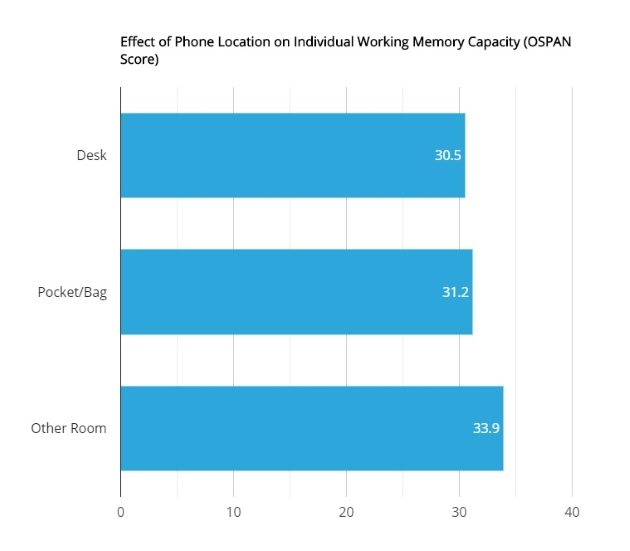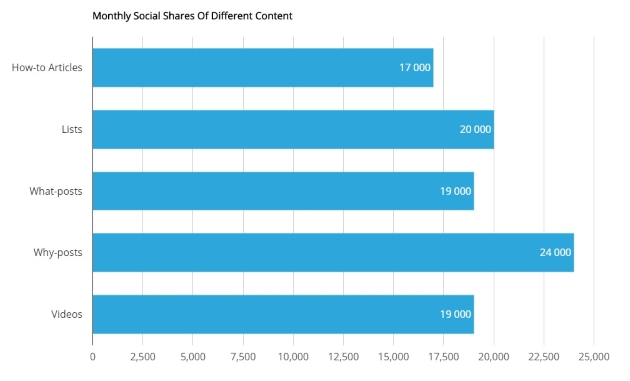
How To Be A “Distraction-Free” Media In The Age of Total Distraction?
Table of Contents
The average person spends approximately 40 seconds at a time staring at one thing on their mobile screen before moving on to something else. That’s about enough time to read a paragraph and study an image. Even you reading this now are likely to be distracted by something before making it to the end of this article. (We dare you to defeat the odds and show your brain who’s boss).
We’re all busy and there are many different types of distractions that can divert a person’s attention. Regardless of whether a friend, a coworker, an ad or social media sidetrack’s a reader’s focus, the media is pressured more than ever to build content that will engage readers to go past that average read time and engage with what they’re reading.

Cognitive Capacity depending on the location of a mobile phone.
Source: The University Of Chicago
So there’s a challenge for a modern media - to create distraction-free reading experiences. The truth is people want to find engaging content; we don’t seek out our Newsfeeds and content for the purpose of being distracted (not always anyway). There’s a plethora of amazing content out on the web, some you’ve probably written yourself, that’s just not being read because the world’s attention span is decreasing almost as fast as technology is advancing. And we can’t stop ourselves.
There are ways to create content and use native “non-distractive” ads that will engage your audience for as long as you need their attention.

It’s not about reaching an audience, but building one
The 2019 WARC Awards listed 3 important insights that more companies and marketers needed to focus on to gain more engagement:
• content needs long term commitment to be effective
• the content resonates with younger audiences
• and real-world components help make content distinctive.
The above quote could be considered the biggest takeaway because it's the one aspect of the content building that many organizations still struggle with. Your content might be amazing, but you’re not going to build an audience if you continue to put your business’ needs ahead of them. Just because you’ve put it in front of their face, doesn’t mean anything.
“If we want to improve our content marketing, we might do well to improve our alignment with our audiences,” says an article on Forbes, “take, say, your top 10% best-performing content, and spin versions of it specifically designed for your most important type of customer. Your most valuable “persona” as content marketers say. This is where priorities come in (and the part that newbie content marketers sometimes miss). Do not try to deliver world-class content services to everyone. As the saying goes, you cannot be all things to all people. Not even Pepsi has that much budget.”

Which types of content are more engaging?
Source: buzzsumo.com
Monetizing a media in the age of distraction looks like a real challenge
“Nobody reads advertising, People read what they want to read, and sometimes it’s an ad.”
– Howard Luck Gossage, Advertising Pioneer, 1969
Display Ads VS Native Ads
As for the ads, it is a good option to place more native ads within your content than distractive classical display ads.
Why?
First, because display ads are expensive and they’re set to get even more expensive as inflation does its part. By 2022, over $97 billion is predicted to be the amount spent on display ads (up from about $68 billion now). Yet the percentage of marketers using this technique is set to decrease.
Second, consumers (and even YOU) hate banner ads, pop-ups, and displays - and companies continue to use them, pay for them, and gain next to nothing in returns. The average click-through rate of banner ads? 0.06%. That’s it. Oh, and 99.6% get an automatic negative feeling towards websites and brands, including media outlets, that use display ads.
Lastly, native ads are increasingly popular and prove that engagement with your audience isn’t lost. People don’t mind seeing advertisements when they’re the ones we don’t mind seeing. If ads are personalized to us, relevant to the content we’re reading, and aren’t distracting us from what we came here to see - we’ll love you forever.
Engaging content is the King
Still with us? Good. For you, here are a couple tips on creating content for your audience and not just for yourself or for fulfilling an editorial plan:
• Create content that aims to build your audience FIRST and the rest will follow on its own. Maya Krampf, CEO of Wholesome Yum’s told What’s New in Publishing how they retain their audience and readers by offering them multiple resources and possibilities to staying committed long term. She says, “We offer multiple ways people can subscribe to follow along with new content we create, including an email newsletter, push notifications, social media communities, and more. In addition, we create more of the same content that may have interested our first-time users, so that they come back for more of what is important to them.”
• Use social media to get the word out and build customer relationships - and benefit from its control of the digital advertising market. Why not distract your audience from the social media they’re already being distracted by? By engaging with your audience, they’re more likely to engage with the content you build and share - plus you’ll know what they want to see.

So native ads are better, then what?
And then, here are 3 tips on how to monetize your media using native ads:
• Blend your paid content in with the content you’re creating, but remember to label the sponsored content as separate from your own. If not, you’ll be going against FTC regulation and will frustrate your audience who clicked believing they were being led to content from your site.
• Ensure the paid content that’s on your website is relevant to your readers’ interests. Try to have those ads be relevant images instead of sponsored brand logos etc.
• Pick a format of native ads that coincide smoothly with your website. It can come from different arrangements, so be sure to choose one that works well with both your desktop and mobile web platforms.
In the age of total digital distraction, media outlets need to use way-out-of-the-box techniques for engaging their content with their audience rather than finding more ways to get it in front of their faces. When it comes to distracting, annoying, and “bad” ads that are ignored or lead readers away, native ads seamlessly blend into their surroundings and tempt readers instead. They act along with your original content to enhance the experience or offer relevant reading/products.
If you found the information in this article insightful, share it with your team and audiences and help set the movement of minimizing distractions into action.




